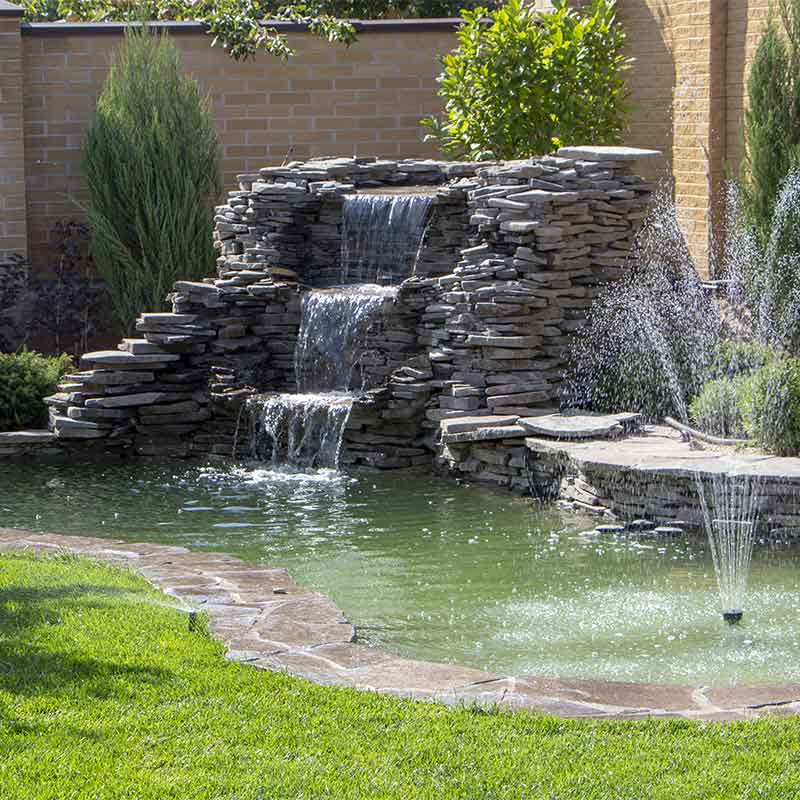
How Outdoor Fountains Work
Fountains have enhanced the serenity of outdoor spaces since the times of the Ancient Greeks. These days, anyone can use an outdoor fountain to transform their backyard into a tranquil oasis.
In addition to looking beautiful, outdoor fountains offer a host of benefits. For example, their soothing streams can mask noisy neighbors and nearby traffic. Better yet, they can attract thirsty birds and butterflies, elevating the vitality and color of your backyard.
Below, we’ll explain how outdoor fountains work and provide a few tips to help you keep yours running smoothly.
Outdoor Fountains: An Overview
Outdoor fountains may be mesmerizing, but their mechanics are fairly simple. Here are the major components that keep outdoor fountains running:
-
Reservoirs – Fountains need water to work their magic, and this water has to come from somewhere. Most outdoor fountains for residential use include easy-to-install, underground reservoirs.
You can dig a hole to accommodate your reservoir and nestle it in according to the instructions. This water will keep your fountain running until it dries up, at which point you’ll need to refill it with a hose.
Some outdoor fountains can connect to your home’s water supply directly. These fountains enjoy a continuous stream of water. However, they may be more difficult and expensive to install.
-
Pumps – In Ancient Greece, outdoor fountains received their water from natural sources. It was funneled into them using the power of gravity.
These days, water pumps provide pressure that pushes water up from the reservoir into the head of the fountain. Once this water falls down into the fountain’s basin, the pump feeds it back to the reservoir, where it’s ready to be used again and again.
There are two types of pumps you can choose from: solar-powered and electricity-powered. Solar-powered pumps are preferable, since they don’t pull from your home’s electrical supply. In turn, they won’t increase your electricity bill. What’s more, you won’t have to hire a licensed electrician to install them.
-
Heads – The head of an outdoor fountain is where the water is released from the pump. The head’s nozzle is responsible for managing how the water is sprayed. You can select a nozzle that sprays water in several directions or choose one that offers a simple, waterfall-like flow.
-
Basins – A basin temporarily stores water that has been released from the fountain’s head until it’s pumped back into the reservoir. Some outdoor fountains have several basins, giving them an elegant, tiered look.
- Valves – Lastly, some fountains allow you to adjust their flow rates using special valves. A fast flow can increase the volume of your fountain’s trickling noises, drowning out any neighborhood ruckus. If you prefer more soft, ambient sounds, you can achieve them by slowing down your fountain’s flow rate instead.
Outdoor fountains can come in a wide variety of eye-catching designs. Some fountains may require just one reservoir and pump, while others may need multiple. Even so, all outdoor fountains function using these basic components.
How to Keep Your Fountain Running Well
After you’ve installed your stunning outdoor fountain, it’ll require adequate positioning and regular maintenance and monitoring.
Here are a few tips to help you do just that:
-
Position it somewhere shady – Since too much sun can encourage excessive algae growth, outdoor fountains should be placed in the shade.
-
Fill it with distilled water – Even if your fountain is perfectly situated away from the sun’s rays, some algae may still develop. Filling your fountain with distilled water is another step you can take to keep the algae blooms at bay.
- Monitor its water levels – If your fountain runs dry, it may damage the pumps. Thus, you’ll need to check your fountain’s water levels regularly to ensure they’re not close to running out. This step is especially important during the warmer seasons.
-
Clean up debris – Since your fountain’s located outdoors, you may notice that leaves, flowers, and other types of debris find their way into its basins. You should remove this debris once a week using a water-skimming device.
-
Do a deep clean every once in a while – It’s a good idea to drain your fountain and wipe down its basins, pumps, and tubing every few months. This process can eliminate any unavoidable debris or algae buildup.
-
Winterize your fountain – If you live in a cold climate, you’ll need to drain your fountain and shut off its water supply before freezing temperatures set in. Otherwise, your fountain may crack.
- Fix leaks right away – If your water fountain has a leak, it won’t go away on its own. You can try to identify the source of the leak on your own or enlist the help of an expert. Either way, you should address the leak as soon as possible.
Power Your Outdoor Fountain With a Solariver Pump
Now that you understand how outdoor fountains work and how to care for them, you may be eager to decorate your yard with one. If so, you can power it using a solar-powered pump from Solariver.
Our solar water pumps are easy to install and operate reliably, even on cloudy days. Since they use sustainable energy, they won’t place a burden on your electricity bill. Best of all, they’re easy to install.
Are you ready to get started? Contact us today to find out more about our solar water pumps.



